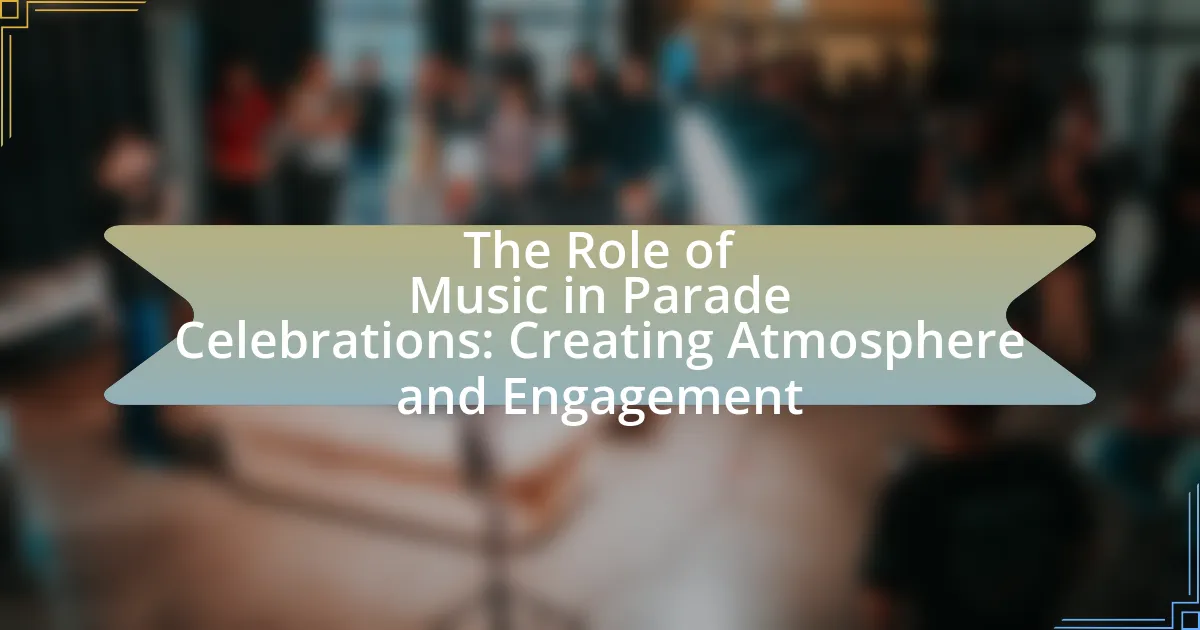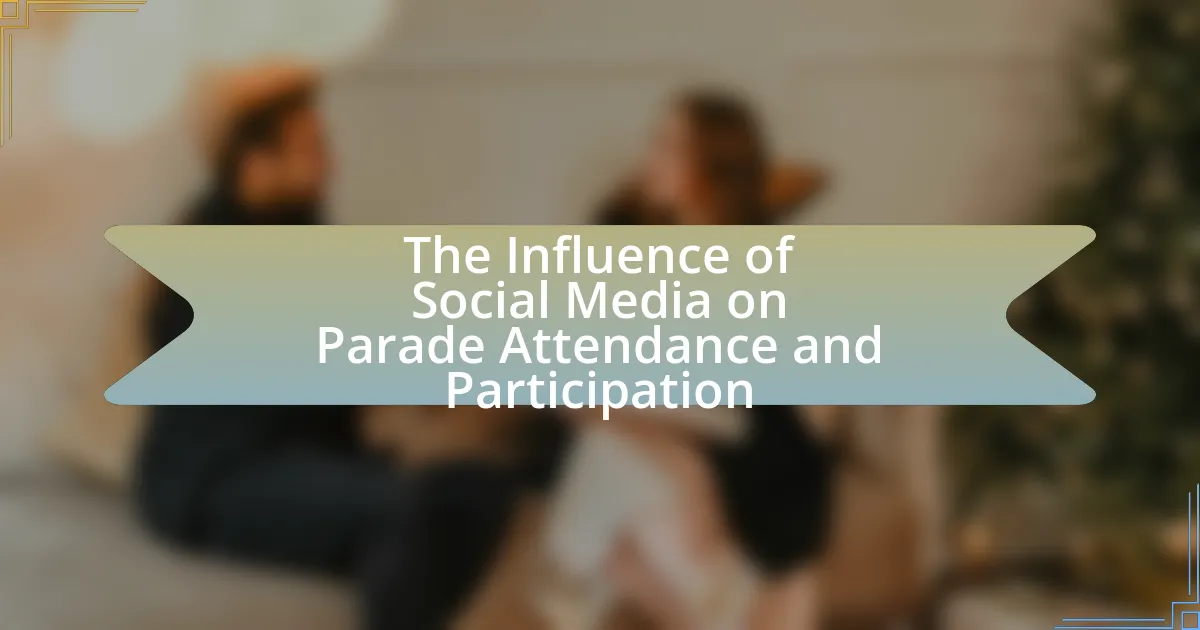Iconic parade floats are large, intricately designed vehicles that play a significant role in parades by showcasing themes and celebrating cultural heritage. This article explores the characteristics that distinguish iconic floats from regular ones, including their elaborate designs, thematic coherence, and cultural influences. It also examines the design process, materials used, and the challenges designers face, such as structural integrity and safety concerns. Additionally, the article highlights innovative trends in float design, including sustainability practices and the integration of technology, emphasizing the importance of these floats in enhancing community identity and the overall parade experience.
![]()
What are Iconic Parade Floats?
Iconic parade floats are large, elaborately decorated vehicles used in parades to showcase themes, celebrate events, or promote cultural heritage. These floats often feature intricate designs, vibrant colors, and creative elements that capture the attention of spectators. For example, the Rose Parade in Pasadena, California, is renowned for its stunning floral floats, which are constructed entirely from flowers and other natural materials, demonstrating the artistry and craftsmanship involved in float design.
How do Iconic Parade Floats differ from regular floats?
Iconic parade floats differ from regular floats primarily in their design complexity and thematic significance. Iconic floats often feature elaborate, artistic designs that reflect cultural narratives or significant events, while regular floats typically have simpler, more generic decorations. For instance, iconic floats in events like the Rose Parade are known for their intricate floral arrangements and storytelling elements, which can take months to create, contrasting with the more straightforward designs of standard floats that may prioritize functionality over artistry. This distinction highlights the role of iconic floats in creating memorable visual experiences that resonate with audiences, thereby enhancing the overall impact of the parade.
What design elements make a float iconic?
Iconic floats are characterized by vibrant colors, innovative shapes, and thematic coherence. Vibrant colors attract attention and evoke emotions, while innovative shapes create visual interest and enhance the float’s narrative. Thematic coherence ensures that all design elements align with a central concept, making the float memorable and impactful. For instance, the Rose Parade floats often utilize intricate floral designs and elaborate structures that reflect the theme of the event, showcasing creativity and craftsmanship. These elements combined contribute to the float’s ability to leave a lasting impression on audiences.
How do cultural influences shape the design of parade floats?
Cultural influences significantly shape the design of parade floats by dictating themes, colors, symbols, and materials that resonate with specific communities. For instance, floats in Mardi Gras parades often incorporate vibrant colors and motifs that reflect New Orleans’ rich history and diverse cultural heritage, such as jazz music and Creole traditions. Additionally, cultural festivals like the Chinese New Year feature floats adorned with dragons and lanterns, symbolizing prosperity and good fortune, which are integral to Chinese culture. These design choices not only celebrate cultural identity but also engage audiences by evoking shared values and traditions, thereby enhancing the overall impact of the parade.
Why are Iconic Parade Floats important in celebrations?
Iconic parade floats are important in celebrations because they serve as visual representations of cultural themes, community pride, and artistic expression. These floats often embody the spirit of the event, engaging audiences through elaborate designs and storytelling elements. For instance, during the Rose Parade, floats are adorned with thousands of flowers, showcasing creativity and craftsmanship while promoting local businesses and organizations. This not only enhances the festive atmosphere but also fosters a sense of unity and belonging among participants and spectators, making the celebration memorable and impactful.
What role do they play in community identity?
Iconic parade floats play a significant role in shaping community identity by serving as visual representations of local culture, values, and history. These floats often incorporate symbols, themes, and narratives that resonate with community members, fostering a sense of pride and belonging. For instance, during parades, floats may showcase traditional crafts, historical events, or notable figures from the community, reinforcing collective memory and shared experiences. This connection is evidenced by studies indicating that community events featuring such floats enhance social cohesion and local engagement, as participants feel a deeper connection to their heritage and each other.
How do they enhance the overall parade experience?
Iconic parade floats enhance the overall parade experience by providing visually stunning displays that captivate audiences and create memorable moments. These floats often feature intricate designs, vibrant colors, and thematic elements that reflect cultural significance or current events, engaging spectators emotionally and visually. For instance, the Rose Parade floats are renowned for their elaborate floral arrangements and artistic creativity, attracting millions of viewers each year and contributing to the event’s festive atmosphere. This combination of artistry and thematic relevance not only entertains but also fosters a sense of community and celebration among attendees.
![]()
What are the key components in designing Iconic Parade Floats?
The key components in designing iconic parade floats include creativity, structural integrity, visual appeal, and thematic coherence. Creativity drives the unique design elements that capture attention, while structural integrity ensures the float can withstand movement and environmental conditions. Visual appeal is achieved through vibrant colors, intricate details, and effective use of materials, which enhance the overall aesthetic. Thematic coherence ties all elements together, ensuring that the float effectively communicates a specific message or story, as seen in events like the Rose Parade, where floats are judged on their adherence to a theme and creativity.
How do designers approach the creative process for floats?
Designers approach the creative process for floats by integrating thematic concepts, visual storytelling, and structural engineering. They begin by brainstorming ideas that align with the parade’s theme, ensuring that the float conveys a clear message or narrative. This is followed by sketching designs and creating models to visualize the float’s appearance and functionality. Designers also consider materials and construction techniques to ensure durability and safety during the parade. For instance, the use of lightweight materials allows for easier maneuverability, while vibrant colors and intricate details enhance visual appeal. This methodical approach ensures that the final product is not only aesthetically pleasing but also structurally sound, contributing to the overall impact of the parade.
What materials are commonly used in float construction?
Common materials used in float construction include wood, metal, foam, and fabric. Wood serves as a structural framework, providing stability and support for the float’s design. Metal is often utilized for its durability and strength, particularly in the framework and support structures. Foam is frequently employed for creating intricate shapes and designs, as it is lightweight and easily manipulated. Fabric is used for covering surfaces and adding decorative elements, enhancing the visual appeal of the float. These materials collectively contribute to the float’s overall design, functionality, and aesthetic impact during parades.
How does the scale of a float impact its design?
The scale of a float significantly impacts its design by dictating the proportions, materials, and structural integrity required for construction. Larger floats necessitate robust frameworks to support their weight and size, often leading to the use of lightweight materials like aluminum and foam to maintain mobility and stability. Additionally, the scale influences visual elements; larger floats can incorporate more intricate designs and features, enhancing their visual impact during parades. For instance, the Rose Parade floats, which can reach up to 55 feet in length, utilize elaborate floral arrangements and mechanical components that are only feasible at such a scale, demonstrating how size directly correlates with design complexity and creativity.
What techniques are used to ensure visual impact?
Techniques used to ensure visual impact in iconic parade floats include bold color schemes, dynamic shapes, and strategic lighting. Bold color schemes attract attention and evoke emotions, while dynamic shapes create visual interest and movement, enhancing the overall aesthetic. Strategic lighting highlights key features and adds depth, making the float more engaging during both day and night parades. These techniques are supported by design principles that emphasize contrast, balance, and focal points, ensuring that the floats stand out in a crowded environment.
How do color schemes influence audience perception?
Color schemes significantly influence audience perception by evoking emotional responses and shaping brand identity. For instance, research indicates that colors can affect mood and behavior; blue often conveys trust and calmness, while red can evoke excitement or urgency. A study published in the journal “Color Research and Application” by Satyendra Singh found that up to 90% of snap judgments made about products can be based on color alone. This demonstrates that effective color schemes can enhance the visual appeal of parade floats, making them more memorable and impactful to the audience.
What role does lighting play in float design?
Lighting plays a crucial role in float design by enhancing visual appeal and creating an engaging atmosphere. Effective lighting can highlight specific features of the float, draw attention to key elements, and evoke emotions in the audience. For instance, the use of LED lights allows for dynamic color changes and patterns, which can transform the float’s appearance throughout the parade. Additionally, studies have shown that well-lit floats can increase viewer engagement and enjoyment, as illuminated designs are more likely to capture attention in a crowded setting.
![]()
What challenges do designers face when creating Iconic Parade Floats?
Designers face several challenges when creating iconic parade floats, including structural integrity, artistic vision, and logistical constraints. Ensuring that the float can support its design while being safe for transport and display is crucial; for instance, floats must withstand various weather conditions and the weight of materials used. Additionally, translating a creative concept into a tangible float that captures the intended message or theme can be difficult, as it requires balancing aesthetics with functionality. Logistically, designers must coordinate with various stakeholders, including builders, sponsors, and event organizers, to meet deadlines and budget constraints, which can complicate the creative process. These challenges highlight the complexity of designing floats that are not only visually striking but also practical and safe for public display.
How do logistical considerations affect float design?
Logistical considerations significantly influence float design by determining the feasibility of construction, transportation, and assembly. For instance, the size and weight of the float must comply with transportation regulations and the dimensions of parade routes, which often have restrictions on height and width. Additionally, materials chosen for the float must be lightweight yet durable to withstand movement and weather conditions, impacting the overall design aesthetics and structural integrity. Furthermore, the timeline for construction is critical; floats must be designed to allow for efficient assembly and disassembly, ensuring they can be transported to and from the parade site without delays. These factors collectively ensure that the float not only meets creative aspirations but also adheres to practical constraints, thereby enhancing its effectiveness in the parade.
What are the common safety concerns associated with parade floats?
Common safety concerns associated with parade floats include structural stability, fire hazards, and pedestrian safety. Structural stability is crucial as floats must support the weight of decorations and performers without collapsing, which has led to incidents where inadequate support resulted in injuries. Fire hazards arise from the use of flammable materials and electrical components, necessitating strict adherence to fire safety regulations to prevent accidents. Additionally, pedestrian safety is a significant concern, as floats often operate in crowded environments, increasing the risk of collisions or injuries to bystanders. These concerns highlight the importance of thorough planning and safety measures in float design and operation.
How do weather conditions impact float design and materials?
Weather conditions significantly influence float design and materials by dictating the choice of construction materials and structural integrity required for stability and durability. For instance, floats designed for rainy weather often utilize waterproof materials like vinyl and treated wood to prevent water damage, while those intended for sunny conditions may incorporate UV-resistant coatings to protect against fading and deterioration. Additionally, wind resistance is a critical factor; floats must be engineered to withstand gusts, which can lead to the use of heavier materials or reinforced structures. Historical examples include the use of aluminum frames in floats for parades in coastal areas prone to high winds, demonstrating the necessity of adapting designs to specific weather challenges.
What are some innovative trends in float design?
Innovative trends in float design include the use of sustainable materials, interactive technology, and modular construction. Sustainable materials, such as recycled plastics and biodegradable components, are increasingly being utilized to reduce environmental impact. Interactive technology, including augmented reality and motion sensors, enhances audience engagement by allowing spectators to interact with the float in real-time. Modular construction enables easier assembly and disassembly, allowing for more complex designs and efficient transportation. These trends reflect a growing emphasis on environmental responsibility and audience experience in the design of parade floats.
How is technology being integrated into float designs?
Technology is being integrated into float designs through the use of advanced materials, lighting systems, and interactive elements. For instance, LED lighting is commonly employed to enhance visual appeal and create dynamic displays, allowing floats to change colors and patterns in real-time. Additionally, lightweight materials such as carbon fiber and advanced composites are utilized to improve structural integrity while reducing weight, enabling more intricate designs. Furthermore, the incorporation of sensors and interactive technology allows for audience engagement, where floats can respond to crowd reactions or incorporate augmented reality features, enhancing the overall experience. These technological advancements not only elevate the aesthetic quality of parade floats but also improve their functionality and interactivity, making them more impactful during events.
What sustainable practices are emerging in float construction?
Sustainable practices emerging in float construction include the use of eco-friendly materials, energy-efficient lighting, and waste reduction strategies. Eco-friendly materials such as recycled plastics and biodegradable components are increasingly being utilized to minimize environmental impact. Energy-efficient LED lighting is being adopted to reduce energy consumption during parades. Additionally, waste reduction strategies, including the reuse of materials from previous floats and recycling post-event, are becoming standard practices. These approaches not only enhance sustainability but also align with growing public demand for environmentally responsible event planning.
What best practices should designers follow for impactful floats?
Designers should prioritize visual clarity, thematic coherence, and audience engagement to create impactful floats. Visual clarity ensures that the float’s message is easily understood from a distance, utilizing bold colors and clear imagery. Thematic coherence involves aligning the float’s design with the overall theme of the parade, enhancing its relevance and resonance with the audience. Audience engagement can be achieved through interactive elements or performances that invite participation, making the experience memorable. These practices are supported by studies indicating that well-designed floats significantly enhance audience enjoyment and retention of the parade’s message.
How can collaboration enhance the design process?
Collaboration enhances the design process by integrating diverse perspectives and expertise, leading to more innovative and effective solutions. When designers, engineers, and stakeholders work together, they can share ideas, identify potential issues early, and refine concepts based on collective feedback. Research indicates that collaborative design teams produce higher-quality outcomes; for instance, a study published in the Journal of Design Research found that interdisciplinary collaboration can increase creativity and problem-solving capabilities by up to 30%. This synergy not only fosters creativity but also ensures that the final design aligns with the needs and expectations of all parties involved, ultimately resulting in more impactful and successful designs for projects like iconic parade floats.
What tips can help ensure a successful parade float presentation?
To ensure a successful parade float presentation, focus on clear themes, vibrant colors, and engaging storytelling. A well-defined theme helps convey a cohesive message, while vibrant colors attract attention and enhance visual appeal. Engaging storytelling through the float’s design and accompanying performance captivates the audience, making the presentation memorable. Historical examples, such as the Rose Parade floats, demonstrate that floats with strong themes and storytelling elements consistently receive high praise and audience engagement.




